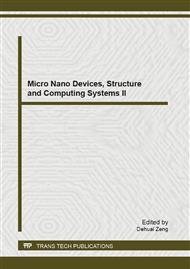[1]
T. -K. Hsu, Y. -F. Tsai, and H. -H. Wu, The preference analysis for tourist choice of destination: A case study of Taiwan, Tourism Management, vol. 30, pp.288-297, (2009).
DOI: 10.1016/j.tourman.2008.07.011
Google Scholar
[2]
S. Jang and C. -M. E. Wu, Seniors' travel motivation and the influential factors: An examination of Taiwanese seniors, Tourism Management, vol. 27, pp.306-316, (2006).
DOI: 10.1016/j.tourman.2004.11.006
Google Scholar
[3]
T. Bornhorst, J. R. Brent Ritchie, and L. Sheehan, Determinants of tourism success for DMOs & destinations: An empirical examination of stakeholders' perspectives, Tourism Management, vol. 31, pp.572-589, (2010).
DOI: 10.1016/j.tourman.2009.06.008
Google Scholar
[4]
R. Nicoletta and R. Servidio, Tourists' opinions and their selection of tourism destination images: An affective and motivational evaluation, Tourism Management Perspectives, vol. 4, pp.19-27, (2012).
DOI: 10.1016/j.tmp.2012.04.004
Google Scholar
[5]
S. Um and J. L. Crompton, Attitude determinants in tourism destination choice, Annals of Tourism Research, vol. 17, pp.432-448, (1990).
DOI: 10.1016/0160-7383(90)90008-f
Google Scholar
[6]
J. L. Crompton and P. K. Ankomah, Choice set propositions in destination decisions, Annals of Tourism Research, vol. 20, pp.461-476, (1993).
DOI: 10.1016/0160-7383(93)90003-l
Google Scholar
[7]
E. Herrera-Viedma, F. Herrera, F. Chiclana, and M. Luque, Some issues on consistency of fuzzy preference relations, European Journal of Operational Research, vol. 154, pp.98-109, (2004).
DOI: 10.1016/s0377-2217(02)00725-7
Google Scholar
[8]
F. Chiclana, F. Herrera, and E. Herrera-Viedma, Integrating three representation models in fuzzy multipurpose decision making based on fuzzy preference relations, Fuzzy Sets and Systems, vol. 97, pp.33-48, (1998).
DOI: 10.1016/s0165-0114(96)00339-9
Google Scholar
[9]
F. Chiclana, F. Herrera, and E. Herrera-Viedma, Integrating multiplicative preference relations in a multipurpose decision-making model based on fuzzy preference relations, Fuzzy Sets and Systems, vol. 122, pp.277-291, (2001).
DOI: 10.1016/s0165-0114(00)00004-x
Google Scholar
[10]
F. Herrera and E. Herrera-Viedma, Choice functions and mechanisms for linguistic preference relations, European Journal of Operational Research, vol. 120, pp.144-161, (2000).
DOI: 10.1016/s0377-2217(98)00383-x
Google Scholar
[11]
F. Herrera, E. Herrera-Viedma, and F. Chiclana, Multiperson decision-making based on multiplicative preference relations, European Journal of Operational Research, vol. 129, pp.372-385, (2001).
DOI: 10.1016/s0377-2217(99)00197-6
Google Scholar
[12]
F. Herrera, E. Herrera-Viedma, and J. L. Verdegay, A sequential selection process in group decision making with a linguistic assessment approach, Information Sciences, vol. 85, pp.223-239, (1995).
DOI: 10.1016/0020-0255(95)00025-k
Google Scholar
[13]
F. Herrera, E. Herrera-Viedma, and J. L. verdegay, A model of consensus in group decision making under linguistic assessments, Fuzzy Sets and Systems, vol. 78, pp.73-87, (1996).
DOI: 10.1016/0165-0114(95)00107-7
Google Scholar
[14]
F. Herrera, E. Herrera-Viedma, and J. L. Verdegay, A rational consensus model in group decision making using linguistic assessments, Fuzzy Sets and Systems, vol. 88, pp.31-49, (1997).
DOI: 10.1016/s0165-0114(96)00047-4
Google Scholar
[15]
T. Tanino, Fuzzy preference orderings in group decision making, Fuzzy Sets and Systems, vol. 12, pp.117-131, (1984).
DOI: 10.1016/0165-0114(84)90032-0
Google Scholar
[16]
Z. Switalski, General transitivity conditions for fuzzy reciprocal preference matrices, Fuzzy Sets and Systems, vol. 137, pp.85-100, (2003).
DOI: 10.1016/s0165-0114(02)00434-7
Google Scholar
[17]
F. Chiclana, F. Herrera, E. Herrera-Viedma, and L. Martínez, A note on the reciprocity in the aggregation of fuzzy preference relations using OWA operators, Fuzzy Sets and Systems, vol. 137, pp.71-83, (2003).
DOI: 10.1016/s0165-0114(02)00433-5
Google Scholar
[18]
T. L. Saaty, Exploring the interface between hierarchies, multiple objectives and fuzzy sets, Fuzzy Sets and Systems, vol. 1, pp.57-68, (1978).
DOI: 10.1016/0165-0114(78)90032-5
Google Scholar


